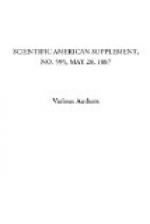It has been suggested that the floods of the valley of the Thames might be controlled by a system of storage reservoirs, and notice was especially drawn to this in consequence of the heavy floods of the winter of 1875. From evidence given before the Royal Commission on Water Supply, previous to that date it was stated that a rainfall of 1 in. over the Thames basin above Kingston would give, omitting evaporation and absorption, a volume of 53,375,000,000 gallons. To prevent floods, a rainfall of at least 3 in. would have to be provided against, which would mean the construction of reservoirs of a storage capacity of say 160,000,000,000 gallons. Mr. Bailey Denton, in his evidence before that commission, estimated that reservoirs to store less than one tenth that quantity would cost L1,360,000, and therefore a 3 in. storage as above would require an outlay of, say, L15,000,000 sterling; and it will be seen that 3 in. is by no means too great a rainfall to allow for, as in July of 1875, according to Mr. Symons, at Cirencester, 3.11 in. fell within twenty-four hours. Supposing serious attention were to be given to such a scheme, there would, without doubt, be very great difficulty in finding suitable situations, from an engineering and land owner’s point of view, for the requisite dams and reservoir areas.
In Great Britain and many European countries rain gauges have been established at a greater or less number of stations for many years past, and data thereby afforded for estimating approximately the rainfall of any given district or catchment basin. The term “watershed” is one which it appears to me is frequently misapplied; as I understand it, watershed is equivalent to what in America is termed the “divide,” and means the boundary of the catchment area or basin of any given stream, although I believe it is frequently made use of as meaning the catchment area itself. When saying that the rain gauges already established in most of the older civilized countries afford data for an approximate estimate only, it is meant that an increase in the number of points at which observations are made is necessary, previous to the design of a reservoir dam on the catchment area above, the waters of which are proposed to be impounded, and should be continuous for a series of five or six years, and these must be compared with the observations made with the old established rain gauges of the adjacent district, say for a period of twenty years previously, and modified accordingly. This is absolutely necessary before an accurate estimate of the average and maximum and minimum rainfall can be arrived at, as the rainfall of each square mile of gathering ground may vary the amount being affected by the altitude and the aspect as regards the rainy quarter.




